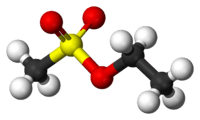Ethyl methanesulfonate
 | |
 | |
| Names | |
|---|---|
| IUPAC name
1-Methylsulfonyloxyethane | |
| Other names
Ethyl mesylate Ethyl methanesulphonate | |
| Identifiers | |
| 62-50-0 | |
| 3D model (Jmol) | Interactive image |
| Abbreviations | EMS |
| ChEBI | CHEBI:23994 |
| ChEMBL | ChEMBL338686 |
| ChemSpider | 5887 |
| ECHA InfoCard | 100.000.488 |
| KEGG | C19239 |
| PubChem | 6113 |
| |
| |
| Properties | |
| CH3SO3C2H5 | |
| Molar mass | 124.16 g/mol |
| Appearance | Clear colorless liquid |
| Density | 1.1452 g/cm3 (22 °C) |
| Melting point | < 25 °C |
| Boiling point | 85–86 °C (185–187 °F; 358–359 K) /10 mmHg(lit) |
| Hazards | |
| NFPA 704 | |
| Except where otherwise noted, data are given for materials in their standard state (at 25 °C [77 °F], 100 kPa). | |
| | |
| Infobox references | |
Ethyl methanesulfonate (EMS) is a mutagenic, teratogenic, and possibly carcinogenic organic compound with formula C3H8SO3. It produces random mutations in genetic material by nucleotide substitution; particularly by guanine alkylation. This typically produces only point mutations. It can induce mutations at a rate of 5x10−4 to 5x10−2 per gene without substantial killing. The ethyl group of EMS reacts with guanine in DNA, forming the abnormal base O-6-ethylguanine. During DNA replication, DNA polymerases that catalyze the process frequently place thymine, instead of cytosine, opposite O-6-ethylguanine. Following subsequent rounds of replication, the original G:C base pair can become an A:T pair (a transition mutation). This changes the genetic information, is often harmful to cells, and can result in disease.
EMS is often used in genetics as a mutagen. Mutations induced by EMS can then be studied in genetic screens or other assays.
See also
References
- ↑ Merck Index, 11th Edition, 3782.
